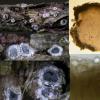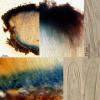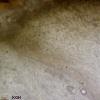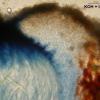
02-01-2026 17:43
MARICEL PATINOHi there, although I couldn't see the fruitbody, I

01-01-2026 18:35
Original loamy soil aside a artificial lake.The co

31-12-2025 19:27
Collected from loamy soil, at waterside (completel

30-12-2025 16:44
Pascal DucosBonjour,Une anamorphe rose stipitée, très nombre

30-12-2025 17:14
 Bernard CLESSE
Bernard CLESSE
Bonjour à toutes et tous,Pourriez-vous aider Albe

29-12-2025 10:15
Hulda Caroline HolteHello, I found and collected this propoloid ascom
Ostropales indet. 1
Hans-Otto Baral,
03-10-2009 18:02
 Still busy with collections from Savoyen Alps. North of Digne-les Bains we collected 4 different species of Ostropales at one place, border of a road near Clues de Barles. All on still-attached dead branches. Two were on Cotinus and easy to identify: Ostropa barbara and Robergea cubicularis. The other two were on Quercus pubescens and I did not even try, because they look quite strange. I have little hope for ideas. Here is one:
Still busy with collections from Savoyen Alps. North of Digne-les Bains we collected 4 different species of Ostropales at one place, border of a road near Clues de Barles. All on still-attached dead branches. Two were on Cotinus and easy to identify: Ostropa barbara and Robergea cubicularis. The other two were on Quercus pubescens and I did not even try, because they look quite strange. I have little hope for ideas. Here is one:branch 6 mm thick. Sp. ca. 300 µm long, *2.8-3.3 µm wide, cells 6-9(-10) µm long, lipid content 1-1.5. Asci inamyloid, basal ca. 1/8 of hymenium IKI 3bb, apical ca. 1/4-1/3 of hymenium 2-3rb.
Zotto
Hans-Otto Baral,
03-10-2009 18:04
Bernard Declercq,
04-10-2009 13:58

Re:Ostropales indet. 1
Hi Zotto,
Your collection macroscopically looks like Schyzoxylon ligustri (Schwein.) Sherwood. The asci in my collection however were only 165-190 µm long and the spores were disarticulating. Maybe you have to further check that genus as far as periphysoids are absent.
Best regards,
Bernard Declercq
Your collection macroscopically looks like Schyzoxylon ligustri (Schwein.) Sherwood. The asci in my collection however were only 165-190 µm long and the spores were disarticulating. Maybe you have to further check that genus as far as periphysoids are absent.
Best regards,
Bernard Declercq
Hans-Otto Baral,
04-10-2009 23:25

Re:Ostropales indet. 1
Hi Bernard
I think that periphysoids are absent, but I will check again. The problem is that the spores are clearly not disarticulating, and therefore one arrives with Sherwood's key at Sch. alboatrum, just the same name as for the other, quite different Ostropales from this collection. When reading Sherwood's diagnosis I can actually not decide which of the two certainly different species fits better.
Zotto
I think that periphysoids are absent, but I will check again. The problem is that the spores are clearly not disarticulating, and therefore one arrives with Sherwood's key at Sch. alboatrum, just the same name as for the other, quite different Ostropales from this collection. When reading Sherwood's diagnosis I can actually not decide which of the two certainly different species fits better.
Zotto
Hans-Otto Baral,
05-10-2009 17:42

Re:Ostropales indet. 1
Here is a section showing that periphyses are absent. Sherwood asks in lead 6 (p. 110) whether the marginal hyphae are brown or hyaline. In my specimen there is both, hyaline and somewhat olive-brown. Going hyaline one comes to the S-American Sch. cordobensis which does not fit too badly.
Hans-Otto Baral,
05-10-2009 17:50








